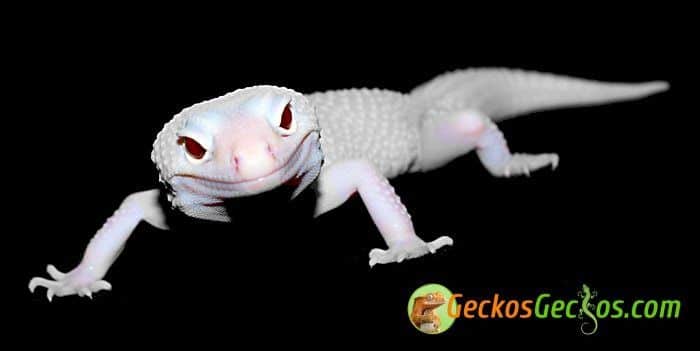Disclaimer: As an Amazon Associate I earn from qualifying purchases. Therefore, we may collect a share of sales from the links on this page, at no extra cost to you!
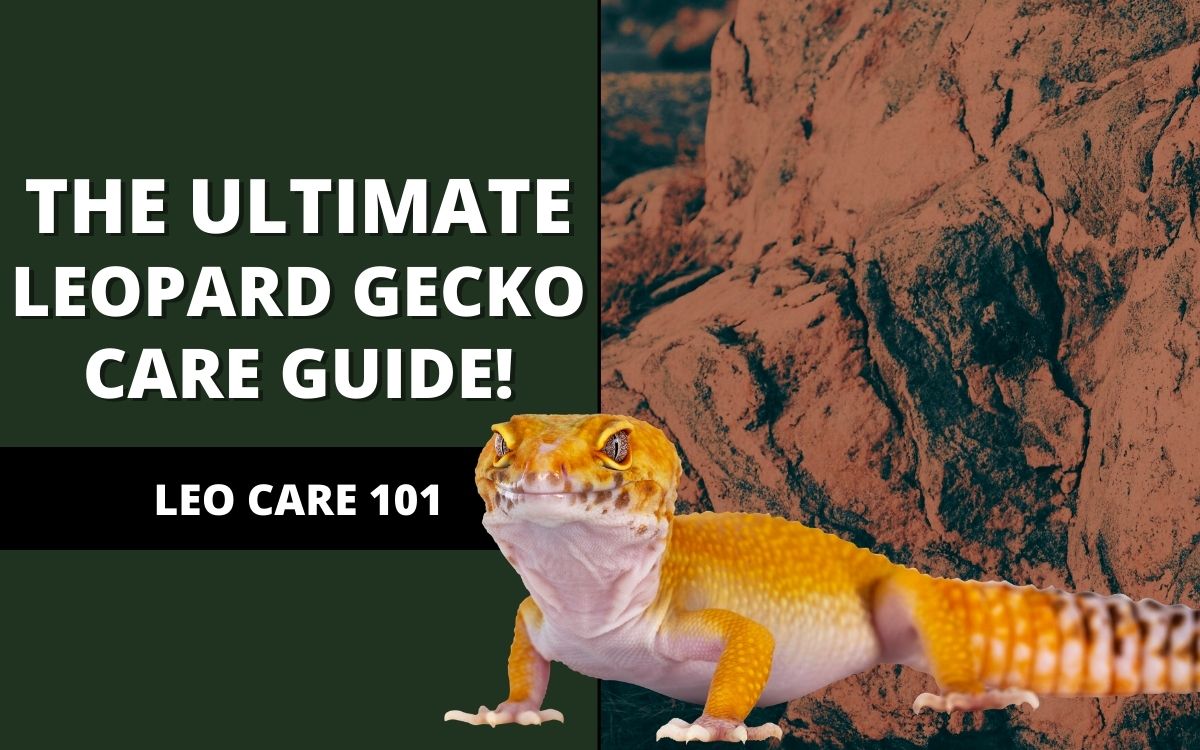
Today’s topics include leopard gecko care, leopard gecko morphs, whether leopard geckos make good pets, housing requirements, diet, handling, and more! Buckle up because this is a long one!
However, in the last two decades Leopard geckos have become one of the most popular pets in the United States. Their calm demeanors, charming looks, and easy care makes them one of the most sought after pet reptiles.
Caring for a Leopard gecko may seem expensive and complicated. However, it’s really not.
Today we’re going to be going over why Leopard geckos make such awesome pets and exactly how to care for them. So, without further ado, here’s out ultimate Leopard gecko care guide!
Feel free to check the table of contents below to skip to a specific section.
Jump to..
Find a Leopard Gecko for Sale
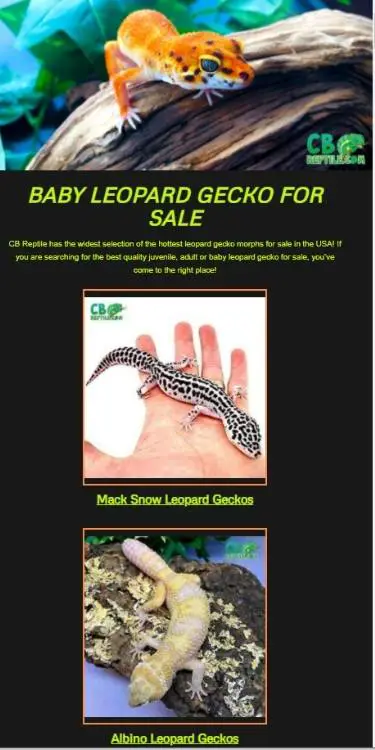
If you plan to get a Leopard gecko as a pet, you should look for a professional leopard gecko breeder.
Only go for Leopard geckos from certified breeders to avoid unnecessary health complications. CBReptiles is the Leopard gecko breeder we recommend. They’re one of the oldest and most successful breeders in the industry. They also have an on-site biologist – so you can be sure you’re getting a healthy reptile!
Be sure to check out their website to see what Leopard geckos they currently have for sale!
Leopard geckos cost between $50 and $500. Some morphs tend to be more expensive than a typical Leopard gecko, so the final decision will be yours to make.
Our Recommended Leopard Gecko Starter Kits:
Leopard Gecko Facts
- Leos can break off their tails to dodge predators.
- Leopard geckos have fat reserves in their tails, which provides them with nutrients when food is scarce.
- Leos are one of the few lizards with moveable eyelids—they can blink and even close their eyes when sleeping.
- Most Leopard geckos eat their shed to prevent predators from following their trail.
- Leopard geckos don’t have sticky toe pads like most lizards, so they cannot climb smooth surfaces.
- Although it may seem concerning, it’s not uncommon for leopard geckos to lose their toes.
- A Leopard gecko can live up to 20 years.
- Leos are polyphyodonts, meaning they can renew their teeth after certain periods.
- Leopard geckos are solitary creatures.
Are Leopard Geckos Good Beginner Pets?
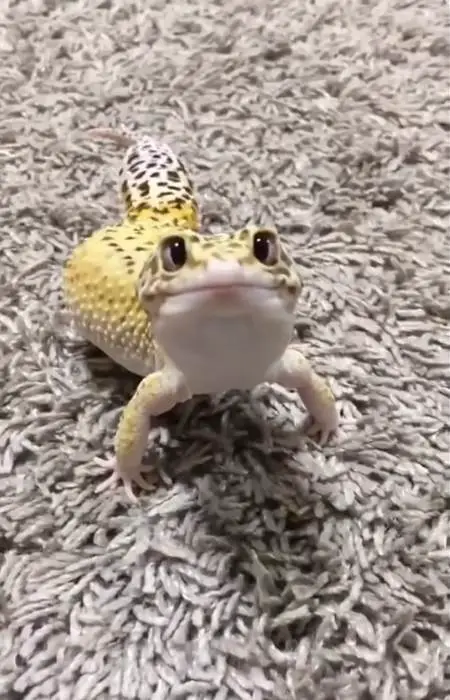
Aside from their aesthetic appearance, Leopard geckos are docile, friendly, and calm creatures. These are some of the many reasons why most people like keeping them as pets.
To elaborate, Leopard geckos don’t require any special care. These lizards have minimal care requirements, so just about anyone can keep a Leopard gecko. Even children can adequately care for one without much help.
They are not too picky when it comes to food. They can eat a variety of insects including mealworms, superworms, hornworms, and more.
Leos are quite interesting, so rest assured you will have fun keeping one. Additionally, you can easily find Leopard geckos in pet stores, online breeders, and reptile expos.
Other Reasons Why Leopard Geckos Are Good Beginner Pets
Leopard Geckos Are Not Temperamental
Besides being docile, Leopard geckos are not temperamental compared to most reptiles. They like to be held and rarely bite. And even if they do, it’s not as painful, so children can handle them without getting hurt.
They Live Long In Captivity
With the right care, a good diet, and proper husbandry, Leopard geckos can outlive most household pets. In the wild, leopard geckos live around ten years on average. However, in captivity, they can live upwards of 20 years!
Leopard Geckos Require Minimal Space
The other good thing about Leopard geckos is that they don’t require a lot of room, thanks to their size. A juvenile Leopard gecko can live in a 10-gallon enclosure. By the time they’re six months old, you should upgrade them to a 20-gallon enclosure.
They Are Easy To Handle
Leopard geckos are not too small, and neither are they too big. You can carry them in the palm of your hand without having to worry about dropping them.
Leopard geckos also tend to move slowly, so you won’t have to worry about them jumping out of your hands.
Leopard Gecko Morphs
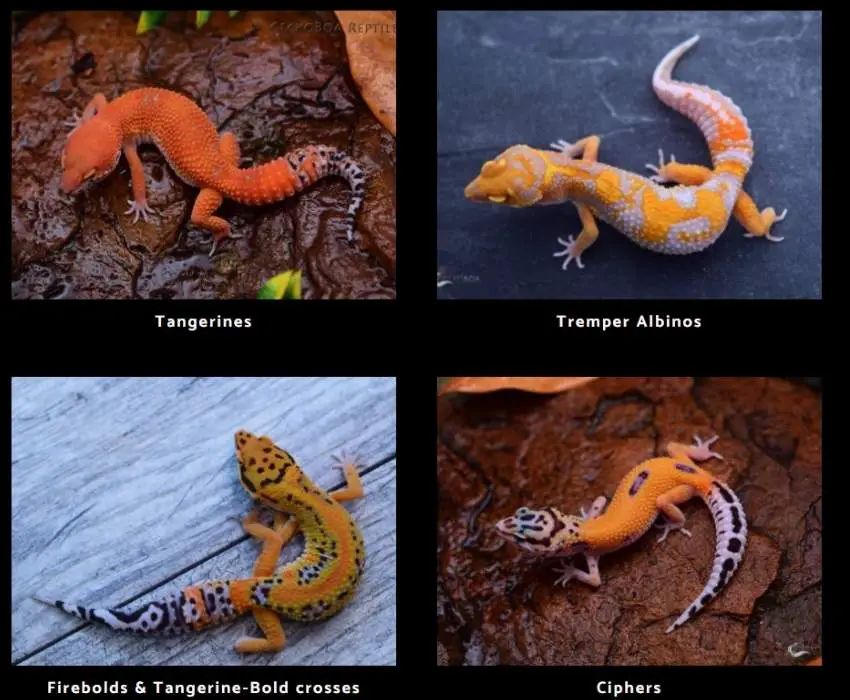
If you are reptile enthusiasts, then you must have heard of the term “morph”. In biology, morph refers to the behavioral or visual differences between organisms of a species.
What is a Leopard Gecko Morph?
A typical Leopard gecko is often yellow with black spots on its skin. However, there are various morphs that look different than a “normal” Leopard gecko.
Leopard gecko morphs are bred through selective breeding, thus resulting in a variation in color and size.
Some of the most common Leopard gecko morphs include:
- Mack Snow
- Albino
- Bold
- Blizzard
- Albino
- Tangelo
- Yellow
- Blood
Here are some images for reference:
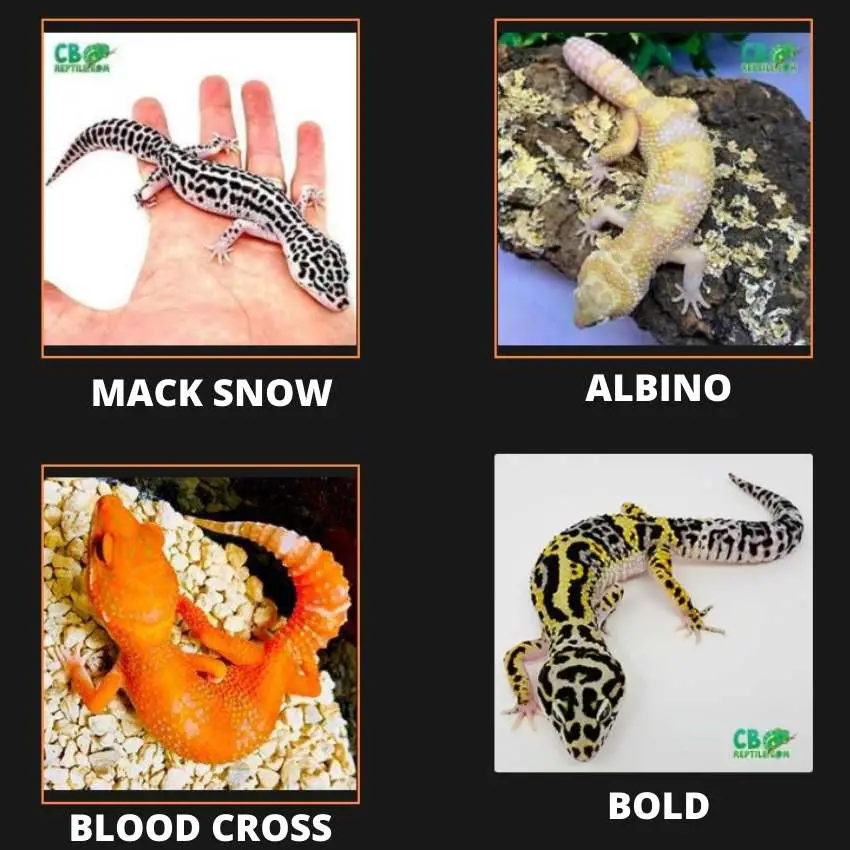
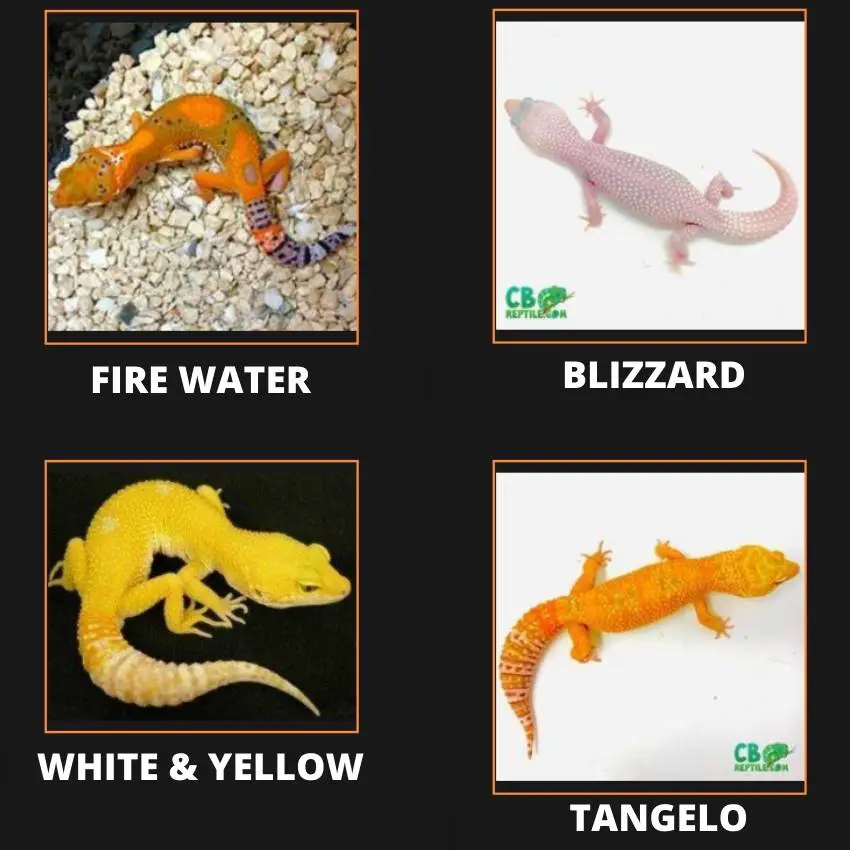
Also, Leopard gecko morphs have unique patterns and are usually more colorful than most lizards. The overall appearance of a particular morph will depend on the genetic traits of both parents.
Through genetic mutation, professional leopard gecko breeders have been able to create over 100 Leopard gecko morphs.
You should expect to see more morphs in the next few years because gecko breeders are getting better at coming up with new types of Leopard gecko morphs.
To get a morph, you need to breed two Leopard geckos with unique traits. You can either use bloodlines or combinations, so you are the one to choose.
Leopard gecko breeding is a complex process, and there are terms that you need to familiarize yourself with to understand better Leopard gecko morphs. However, we will touch more on this later!
Hatchling Leopard Gecko Care
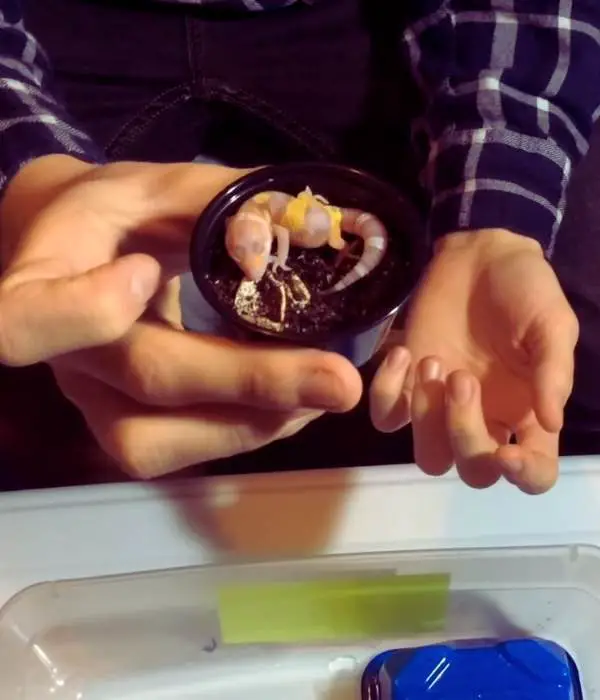
Leopard gecko hatchlings are more delicate than adults, so you need to handle them with care.
Plus, hatchlings should be left inside the incubator for up to twelve hours after they come out of the egg.
Moreover, hatchlings use up a lot of energy when breaking through the shell, so this will allow them to regain the lost energy. That being said, you shouldn’t bother newly hatched Leopard geckos.
There is also a likelihood that the hatchling will be afraid of you at first. As such, you should give them time to adapt to their environment.
Once the 12 hours elapse, you can move the hatchlings to a new enclosure where they can grow and move freely.
Caring For Baby Leopard Geckos: Juvenile Leopard Gecko Care
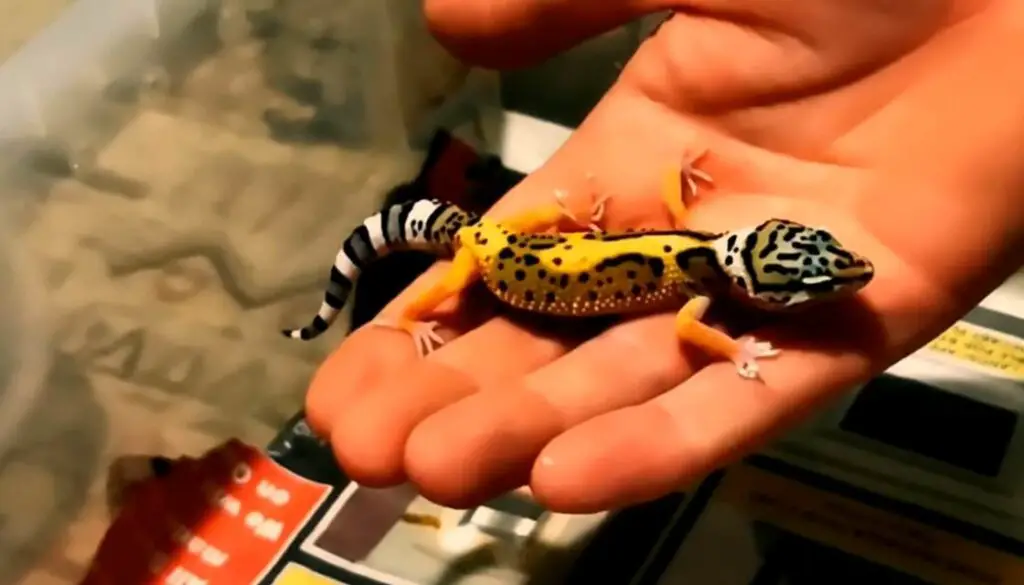
There are several things that you should consider when designing a set up for baby Leos.
Most Leopard gecko keepers use tubs since they offer enough space for all the items that the baby gecko needs.
Like adult geckos, juveniles and hatchlings need a reliable heat source to stay warm. In addition to this, the tub should have the right moisture levels.
Low temperatures and humid conditions can predispose the baby Leopard geckos to respiratory infections such as pneumonia.
Juvenile and hatchling geckos also need hides. This will provide them with a place to hide when they are spooked. You should also place a food bowl and a water cup inside the tub.
When choosing a substrate for baby geckos, you should go for paper towels or reptile carpets because they are safe.
Loose substrates, such as sand, can cause digestion problems and impaction in juveniles and baby Leopard geckos.
Impaction is when food becomes lodged in the digestive tract. It can result in serious health complications that may endanger the life of your Leopard gecko. Hence, it’s imperative to choose an adequate substrate.
Leopard Gecko Habitat
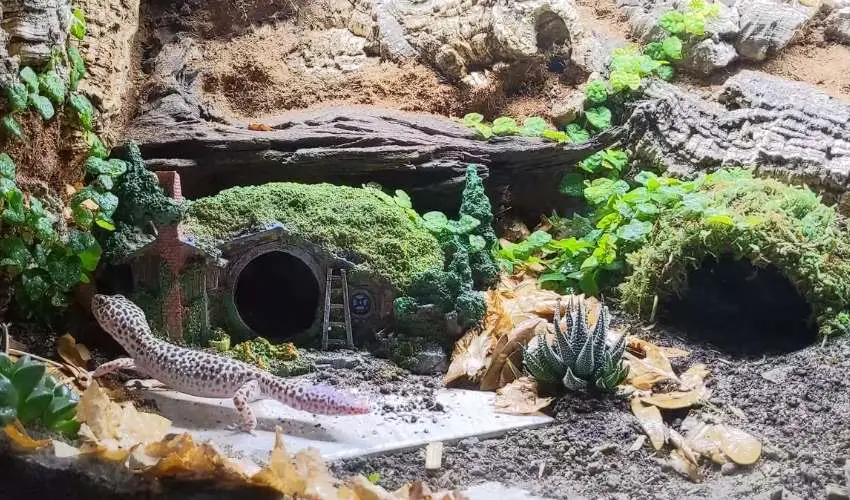
In the wild, Leopard geckos live in arid and semi-arid environments. Most of these areas have sparse vegetation and are often rocky, thus providing Leos with places to hide.
If you want your captive Leopard gecko to feel at home, you should design a habitat that mimics their natural environment. Besides, the market has a wide range of items that you can use when creating your Leopard gecko’s habitat.
Hides are essential for Leopard gecko habitats because they provide the lizards with safe hiding spots.
In addition to hides, you can place small branches and plants on which the Leopard geckos can climb. This will enable the lizards to exercise without leaving the enclosure.
When choosing items for the enclosure, you should only go for non-toxic plant materials. Alternatively, you can use fake branches and logs since they are just as effective.
The items should be arranged in such a way that the Leopard gecko can move freely inside the vivarium.
Leopard Gecko Tank Size: Choosing The Right Tank For Your Leo
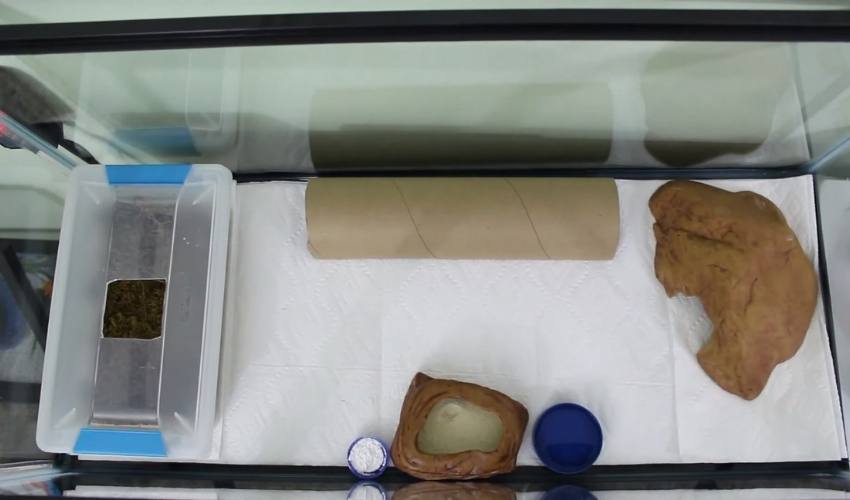
Choosing an appropriate tank for your Leopard gecko is one of the best things that you can do for the lizard.
You should choose tanks based on the gecko age, size, and the number of geckos that you intend to keep. As such, adult Leopard geckos require larger tanks and vice versa.
If you go for a smaller tank, your Leopard gecko may experience several problems. They won’t have enough space to roam and are more likely to get distressed.
Choosing Tanks For Baby Leopard Geckos
Baby Leopard geckos don’t require a lot of space during the early stages of growth. However, you need to keep in mind that they grow very fast, so they can easily outgrow the tank.
Most lizard keepers house baby geckos in 10-gallon tanks in the first few months. A tank of this size can only accommodate one baby gecko at a time.
You should avoid crowding baby geckos in small enclosures since this can affect their health. The lizards should have a large ground area that allows them to run around as much as they want.
Here are the leopard gecko tanks we recommend for baby Leopard geckos:
Adult Leopard Gecko Tanks
On average, a fully grown Leopard gecko requires a 20-gallon tank. However, to give your Leopard gecko more space, you can buy a larger tank.
It’s important to note that you will have to upgrade your tank if you start with a 10-gallon. Thus, many people opt to start with a 20-gallon tank to prevent having to upgrade later on.
What Type Of Tank Should I Buy For My Leopard Gecko?
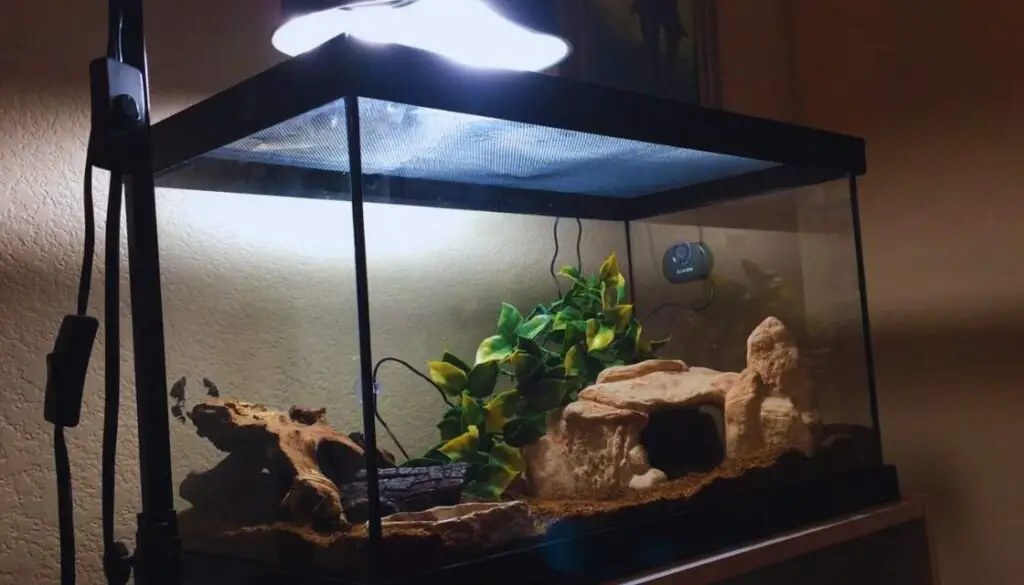
Leopard gecko tanks not only vary in size but are also made of different materials. Plus, not all gecko tanks are the same, so you should make it your goal to ensure that you choose the right tank.
Here are some adult leopard tanks we highly recommend:
The common types of tanks used in housing Leopard geckos are:
Glass Tanks
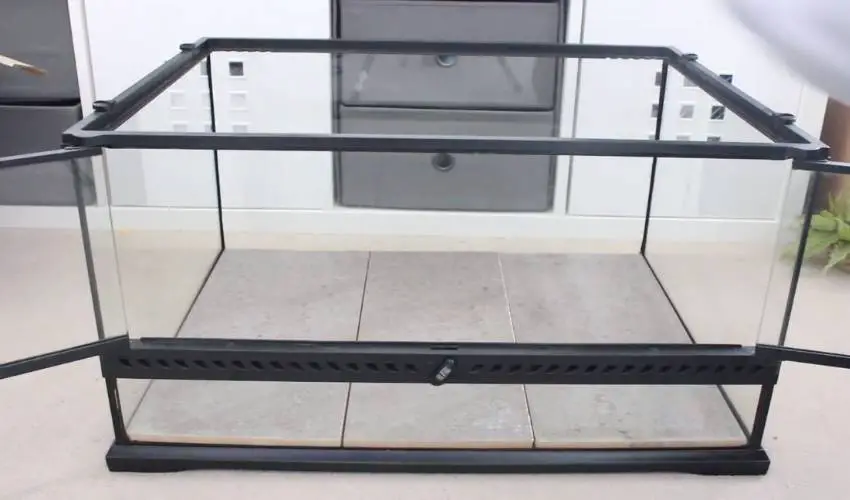
Glass tanks are a favorite among Leopard keepers, and they are for a good reason. First off, they are easy to clean, so you won’t have a hard time disinfecting the enclosure.
Additionally, you can easily install thermostats and other pieces of equipment inside glass tanks. Most of these items come with suction cups that you can stick onto the glass wall.
To add to their list of benefits, glass enclosures can maintain favorable humidity levels, thus preventing dehydration in Leopard geckos.
The fact that they are chemically stable makes them even better since they won’t release any chemicals that may harm your lizard.
Glass enclosures have transparent walls through which you can observe your Leopard gecko. As such, you won’t have to take the gecko out of the enclosure every now and then.
You should be careful when handling glass enclosures since they can break when they fall.
Plastic Tubs
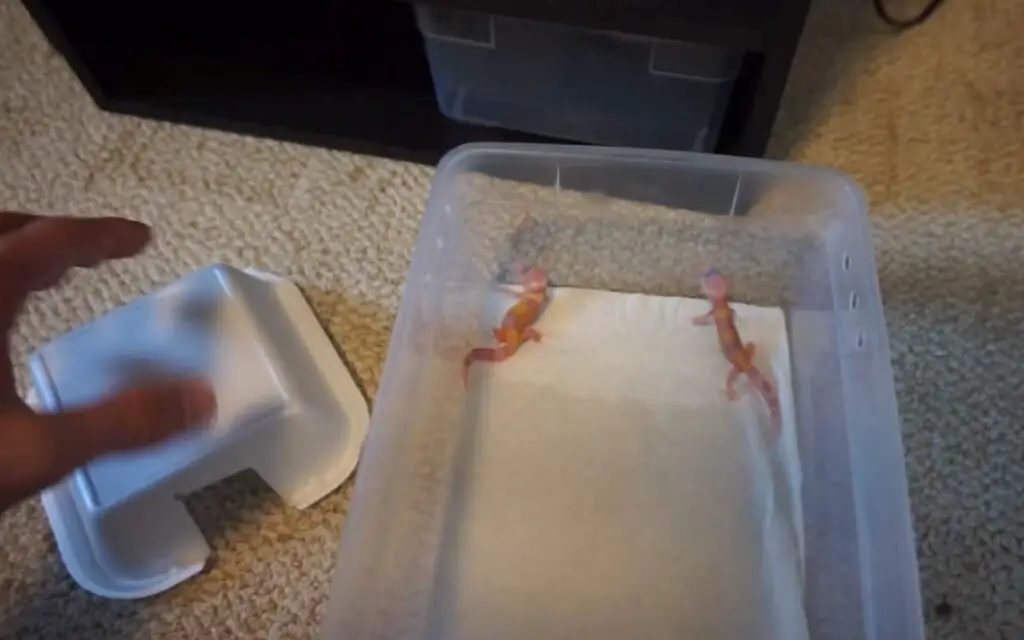
Plastic Leopard gecko tanks are also popular among lizard keepers. They are cheaper than glass tanks, making them an ideal option for people on a tight budget.
Most plastic Leopard gecko tubs are made of ABS or PVC material. Both materials are durable, so that you can go for either.
Unlike glass enclosures, plastic tanks are lightweight and are also less prone to breakage. On the downside, they may become translucent over time, especially when they are scratched multiple times. However, be sure to use a 15qt tub minimum.
Wooden Tanks
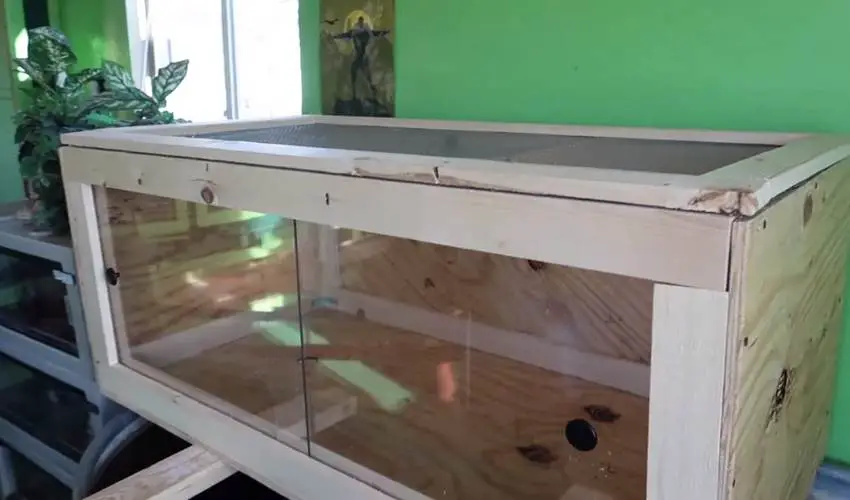
Besides plastic and glass, some Leopard gecko enclosures are made of wood. Nonetheless, wooden gecko tanks are not as common since they typically require hours of building.
Wooden tanks are incredibly durable, and you can make them as large as you’d like. One disadvantage of using wooden tanks is that prone to mold. To prevent this, you should avoid wetting the wood when cleaning the enclosure.
Also, wooden tanks are difficult to clean because the walls are porous. Some Leopard gecko keepers fix this problem by coating the wood with a waterproof finishing.
Wooden Leopard gecko tanks have a glass side that will give you a clear view of the lizard.
Leopard Gecko Tank Setup: How Do I Set Up My Leopard Gecko’s Home?
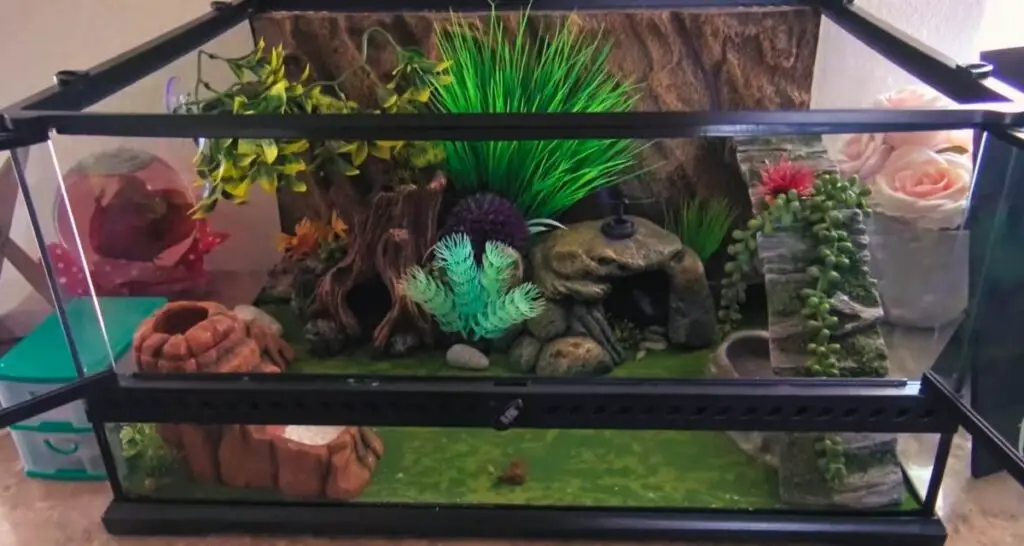
Designing a setup for Leopard geckos is not as complicated as it may sound. You just need to know what to include inside the enclosure and where to put it.
Moreover, Leos don’t require special care, so they can live happily without needing any specialized equipment.
To make it even better, most of the items that you may need are readily available and equally affordable.
When coming up with a Leopard gecko setup, the first rule is to ensure the decoration items somewhat resembles those in the gecko’s natural environment.
As discussed earlier, you can either go for real or artificial decorations. However, all the items should be pet-safe to avoid poisoning the lizard.
If you are planning on getting a Leopard gecko for the first time, you should do a lot of research.
By basing your research on the type and number of geckos that you intend to keep, you will find all the important information that you need.
Besides, not all Leopard geckos are the same, and neither do they need the same setup. For instance, Albino morphs are highly sensitive to light, so their setup may be a bit different from normal geckos and other morphs.
Nevertheless, there are basic items that you must incorporate in your Leopard gecko’s setup.
Essential Items for Leopard Gecko Set Up
- Appropriate size vivarium
- Heat source
- Suitable substrate
- Thermostat
- UVB lamp
- Hygrometer
- Food and water dishes
- Hides/decorations
Here are the products we recommend:
Tips for Designing Leopard Gecko Set-Ups
Unlike most household pets, Leopard geckos are ectotherms, meaning they solely rely on ambient heat to stay warm.
As such, the first thing that you should consider when designing your geckos set up is the type of heat source that you will use. The other items are equally essential for Leopard geckos.
Heat Source: Leopard Gecko Temperature
Most reptile keepers use heat mats and heat tape in their leopard gecko enclosure. This heating technique is not only efficient but also safe for Leopard geckos.
To get the best results, ensure that you place the heating mat underneath the tank. This way, your lizard will be safe even if something goes wrong with the electrical system.
Leopard geckos thrive when the temperature is kept at 77°F to 90°F.
With the help of a thermostat, you can effectively regulate the temperature levels, thus providing your lizard with favorable conditions.
Plus, most thermostats are automated, allowing for hands-free temperature regulation. Still, you need to check the equipment regularly to ensure that everything is working as it should.
The size of the heating mat may vary depending on how large or small the enclosure is. Nonetheless, the mat should cover 1/3 of the total ground area.
Also, the heating mat should be placed on one side of the tank. This will provide the lizard with a warm and cool section, allowing for optimum thermoregulation.
When the gecko’s body temperature is too high, the lizard will move to the cool zone. The reverse is true when their body temperature is low.
Pro Tip: You should avoid heat rocks since they are likely to overheat, thereby causing harm to your lizard.
Leopard Gecko’s Lighting Set Up
You can mimic your Leopard gecko’s natural environment by including UV lights inside the enclosure.
Leos don’t fully rely on UV light like most lizards. However, you can still install a UV lamp around the enclosure since it can help boost the lizard’s vitamin D levels.
According to experts, Leopard geckos should get UV light up to 12 hours per day. With this, the Leopard gecko will have an easy time differentiating day and night.
Some lighting systems have timers that will automatically power down the UV lamp after a certain period of time. As such, you won’t have to make manual adjustments every twelve hours.
Most UV lamps also produce heat, so ensure that you factor in this when buying a light source.
If the lamp and the heating mat work at the same time, the temperatures inside the enclosure may rise above the recommended limit.
This will not only cause discomfort to your Leopard gecko but may also result in dehydration.
You can prevent this by using only one heat source at a time. This will allow you to regulate the temperatures to the right levels without overheating the tank.
That being said, always check the specifications of the UV lamp before buying the item. If you already have a heating mat, you should go for light-only UV bulbs.
Leopard Gecko Humidity Levels
In as much as Leopard geckos thrive in arid environments, they still need moisture-rich air. The humidity levels inside your Leo’s tank should be between 30% and 40%.
You can accurately measure humidity levels inside gecko enclosures using a hygrometer. If the humidity level falls or rises beyond the recommended limit, your lizard may have several health complications.
Most shedding problems in Leopard geckos occur due to inappropriate humidity levels. You can increase humidity by misting the enclosure from time to time.
Nevertheless, you shouldn’t apply too much mist as this will soak up the substrate. Such conditions may predispose your lizard to life-threatening bacterial problems.
The substrate is also more likely to be infested with mold if it gets too wet. Leopard gecko keepers can also regulate humidity by providing the lizard with proper ventilation.
Leopard Gecko Hides
Hides can prove helpful for Leopard geckos, especially when there are light lamps around or inside the enclosure. Gecko hides come in different sizes and also vary in terms of design.
With the right hideout, your Leopard gecko won’t feel uncomfortable even if there is too much light in the environment.
In a Leopard geckos set up, hides should be kept away from the heating spot. This way, the lizard will be able to cool off inside the hide when temperatures are high.
You should consider buying a spacious hide that can accommodate your Leopard gecko. Also, most lizard enthusiasts recommend that you place at least two hides in each enclosure.
Leopard Gecko Substrate
There are different types of Leopard gecko substrates that you can choose from. However, not all substrates are good for Leos.
Lizard keepers report that most substrates can cause impaction in Leopard geckos and should, therefore, be avoided. This mostly applies to loose substrates such as sand.
Leopard geckos and other captive lizards often eat the substrate inside their enclosure by accident. This can occur when the lizard is gobbling its food from the ground or when it is eating its shed.
If you notice that your Leopard gecko is eating substrate, it could be they are lacking in certain nutrients.
Nevertheless, this does not mean that you should let them eat it. Aside from impaction, substrates are known to cause other gastrointestinal complications in Leopard geckos.
Most Leopard gecko keepers prefer tile substrates because they are easy to clean. Plus, they are affordable and readily available in most pet stores.
The other advantage of using tile substrates is that they retain heat and also don’t hold odors. Textured tiles are highly preferred for Leopard gecko set ups since they maximize traction.
Leopard Gecko Diet—What Do Leopard Geckos Eat?
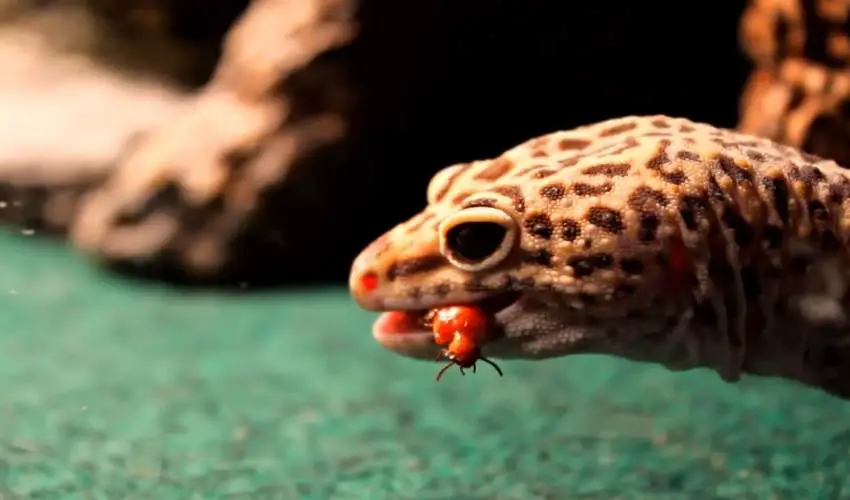
Knowing what your Leopard gecko can or cannot eat is important because this will help you avoid unnecessary guesswork when feeding your pet lizard.
Leopard geckos only eat insects since they are carnivorous animals. In fact, they like eating their prey while it is still alive, so you should consider tossing some insects inside the vivarium to satisfy the lizard’s hunting instincts.
This is one of the effective ways through which you can make your gecko feel like it is in its natural habitat.
Nonetheless, this should only be done in vivariums with a substrate that is not loose. Your Leopard gecko’s diet should be varied in that the lizard should be fed different types of insects.
Crickets and mealworms are favorites among captive lizards, and Leopard geckos are no exception. It is advisable that you gut-load the insects before feeding them to your Leo.
Gut loading is a nutrient-enhancing process in which the gecko’s prey is fed highly nutritious foods a few hours before the feeding session.
As a result, the Leopard gecko will absorb all the nutrients that it needs when it eats the prey. Waxworms, cockroaches, superworms, and butterworms should also be included in your gecko’s diet.
However, Leopard geckos should only eat superworms and waxworms once in a while since they have high-fat content.
Leopard Gecko Handling: Tips For Handling Leopard Geckos Safely
If you are new to keeping Leopard geckos, you need to learn how you can handle the lizard without causing them discomfort.
Here are some tips that you can use when handling Leopard geckos:
Support The Whole Body
When handling a Leopard gecko, ensure that you place the lizard in such a way that all parts of its body are supported by your fingers. This not only makes them feel secure but also prevents them from falling.
Be Gentle
Leopard geckos are small and delicate, so you should not apply too much pressure on the lizard’s body as this may cause injuries.
Never Lift Your Leopard Gecko By The Tail
Like most animals with tails, Leopard geckos don’t like being handled by their tail. Doing so will cause distress to the lizard and they may also break off their tail.
Give The Gecko Time to Adjust To Its Environment
If you just got your Leopard gecko, ensure that you give the lizard enough time to get used to you and its habitat. Also, try as much as you can not to spook the lizard when handling it for the first time.
Start Handling Your Leopard Gecko In The Early Stages
Handling your Leopard gecko in the early stages, especially when it is still young can help you form a strong bond with the reptile. As such, they will feel safe when they are around you.
How Long Do Leopard Geckos Live? Leopard Gecko Lifespan
With proper husbandry and a balanced diet, Leopard geckos can live for 10 to 20 years. However, there may be variations depending on whether the lizard is male or female.
According to gecko experts, female Leopard geckos have a shorter lifespan than male geckos.
On average, male Leos can live for 15 to 20 years, while females have a life expectancy of 10 to 15 years. If given the right care, your Leopard gecko can live a long happy life, so ensure that the lizard is eating healthy.
Also, you should keep your pet lizard in a conducive environment to prevent diseases and other complications.
Are Leopard Geckos Nocturnal?
No. Leopard geckos are crepuscular, meaning they are most active during twilight. In the wild, Leos go out to hunt at dusk and dawn.
Captive Leopard geckos also display this behavior because it is instinct-driven.
However, most people believe that Leopard geckos are nocturnal animals since they spend most of their time sleeping during the day and tend to be more active at night.
Leopard Gecko Size: How Big Do Leopard Geckos Get?
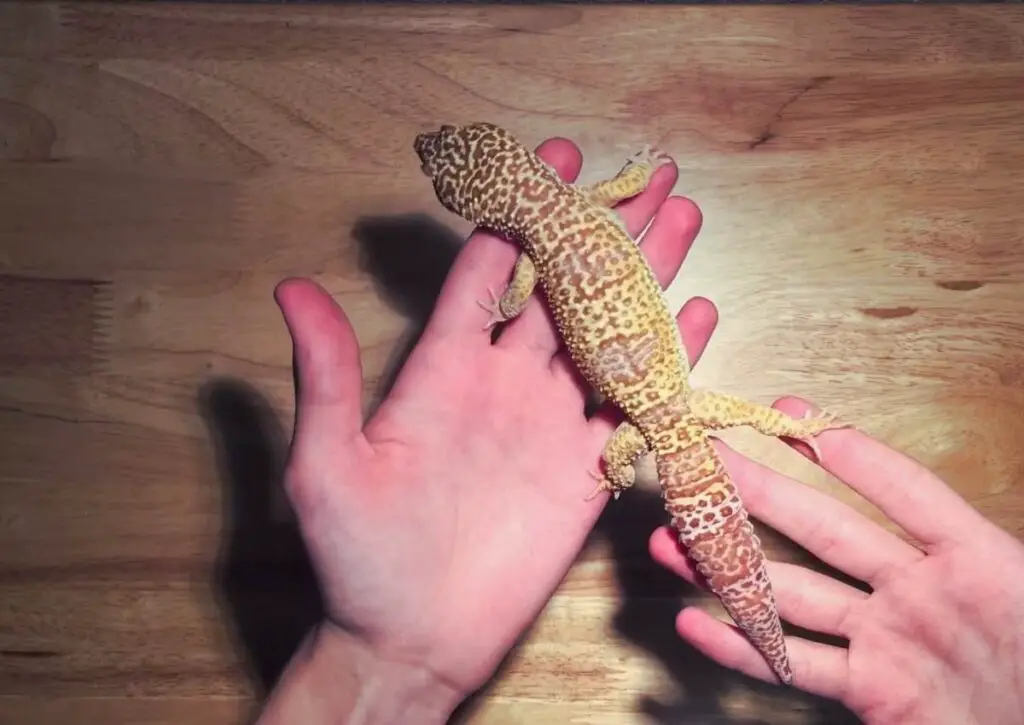
As a pet parent, knowing the exact size by age can help you determine whether your Leopard gecko is healthy or not.
Moreover, certain health complications may prevent your Leo from growing as it should. Learning about these problems will enable you to recognize common developmental problems such as stunted growth.
Aside from that, you will have an easy time when designing an enclosure for your lizard friend. Always keep in mind that the size of the enclosure can also impact the lizard’s health.
So how big do Leopard geckos get? When it comes to size, the measurements may vary depending on whether the gecko in question is male or female.
On average, male Leopard geckos can measure anywhere between 8 inches and 10 inches. On the other hand, a fully grown adult female can be 7-8 inches long.
The above measurements account for the distance between the lizard’s snout and the tip of the tail. In terms of weight, female Leopard geckos can weigh 45-70 grams, while males weigh 60-90 grams.
How Fast Do Leopard Geckos Grow?
Like most organisms in the animal kingdom, Leopard geckos experience spurt growth when they are young. As such, hatchlings and juveniles tend to grow faster than adults.
In fact, juvenile Leopard geckos grow so fast that they can reach their adult size in just one year. Nonetheless, this will all depend on the type of husbandry that the lizard is getting.
Healthy hatchlings usually measure 2.5-3 inches and can weigh 3 to 5 grams. If your Leopard gecko is less than 30 grams, it means it is still a juvenile.
Juvenile geckos may take up to ten months to reach adulthood. Most Leopard geckos weigh between 40g and 90g after a year. Nevertheless, some morphs can weigh up to 120g.
Leopard Gecko Growth Chart
| Age in Months | Length in Inches | Weight in Grams |
|---|---|---|
| Hatchling | 2.5-3 | 3-5 |
| 1 | 4 | 15-20 |
| 2 | 5 | 18-30 |
| 4-6 | 5-6 | 25-60 |
| 9-18 | 8-11 | 40-120 |
The above values only apply to healthy Leopard geckos, so ensure that your lizard gets everything that it needs.
Plus, several factors can affect the growth rate in Leopard geckos. However, most growth problems can easily be avoided with the proper care.
To achieve this, you have to know the things that can prevent your gecko from growing improperly.
Factors That Influence Growth Rate in Leopard Geckos
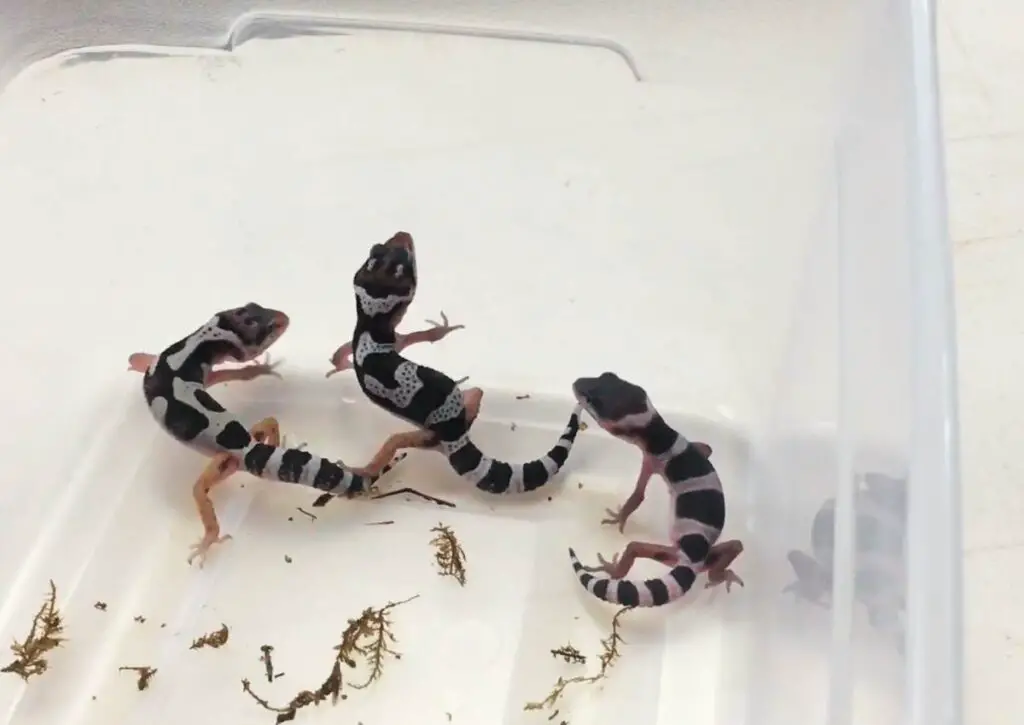
Leopard geckos require certain conditions to achieve optimal growth. If you don’t provide your lizard with the right care, they are likely to experience stunt growth.
Below are the common factors that can affect the growth rate in Leos:
#1. Poor Diet
For your Leopard gecko to stay healthy and grow optimally, it needs a proper diet. As such, ensure that you feed the lizard the right types of food.
Unlike most lizards that eat both insects and vegetables, Leos only eat insects. Your gecko’s diet should include high-protein foods such as crickets, Dubia roaches, butterworms, silkworms, waxworms, etc.
Juveniles, in particular, require high amounts of protein since it helps them grow faster. The same applies to hatchlings, so you should see to it that your pet is eating the right foods.
In addition to this, Leopard geckos require a calcium-rich diet. Calcium is essential for Leos as it aids in the formation of strong bones.
A poor diet can cause nutritional deficiencies, which will, in turn, result in growth problems and other health complications.
#2. Diseases
The disease can cause serious damage to the lizard’s skeletal structure. Also, NSHP can cause stunted growth, meaning your lizard will be shorter than it should at a certain age.
#3. Genetics
Certain genetic traits can cause variations in growth rate and size in Leopard geckos. For instance, some Leopard gecko morphs grow faster than others and also tend to be bigger than regular geckos.
#4. Parasites
Besides diseases, the growth rate in Leopard geckos can also be affected by parasites. Some intestinal parasites can cause severe diarrhea in Leos.
This can result in reduced growth and sudden weight loss. Coccidian and pinworms are some of the most common parasites in Leopard geckos.
These parasites rarely harm Leopard geckos when they are in small numbers. However, lizards with weak immune systems and other underlying health conditions can suffer greatly from a parasite infestation.
#5. Inappropriate Temperature Conditions
Maintaining the right temperature conditions inside a Leopard gecko’s enclosure is very important.
For starters, low-temperature conditions can slow down the digestion process in Leopard geckos, meaning the lizard won’t get the nutrients that it needs in good time.
As such, the gecko may lack essential nutrients such as calcium, thereby causing growth complications.
Additionally, the temperature has a direct effect on the gecko’s metabolism and other biological processes in the body.
Leopard geckos perform and grow optimally when they are exposed to the right temperature conditions.
Ensure that you keep the temperature levels at a favorable level at all times to avoid possible health complications.
#6. Nutrient Transfer
Your Leopard gecko may stop growing temporarily when recovering from diseases. This can also occur when the lizard is healing its tail.
What happens is that the Leopard geckos tend to use a lot of energy when repairing body tissues.
As such, most of the nutrients that could have been used for growth are redirected for repair functions.
You can boost the healing process by providing the lizard with a healthy diet that is also varied.
But most importantly, ensure that the gecko eats enough food as this will provide them with enough energy.
#7. Bullying
Bullying is common among Leopard geckos, especially those of the male species. If you house two or more male geckos in the same enclosure, the largest gecko is likely to bully the others.
In Leopard geckos, bullying occurs when the lizards fight over food, water, and the basking spot.
As a result, the small lizards won’t be able to eat properly since the larger geckos will eat everything.
Apart from that, the weak lizards will not get enough warmth, resulting in severe digestion problems.
If you notice that one of your Leopard geckos is bullying the others, you should consider keeping each gecko in a separate vivarium.
Removing the bully will only leave room for another Leopard gecko to become the new bully, so the best that you can do is split the colony.
Leopard Gecko Care—How to Keep Your Leopard Gecko Healthy
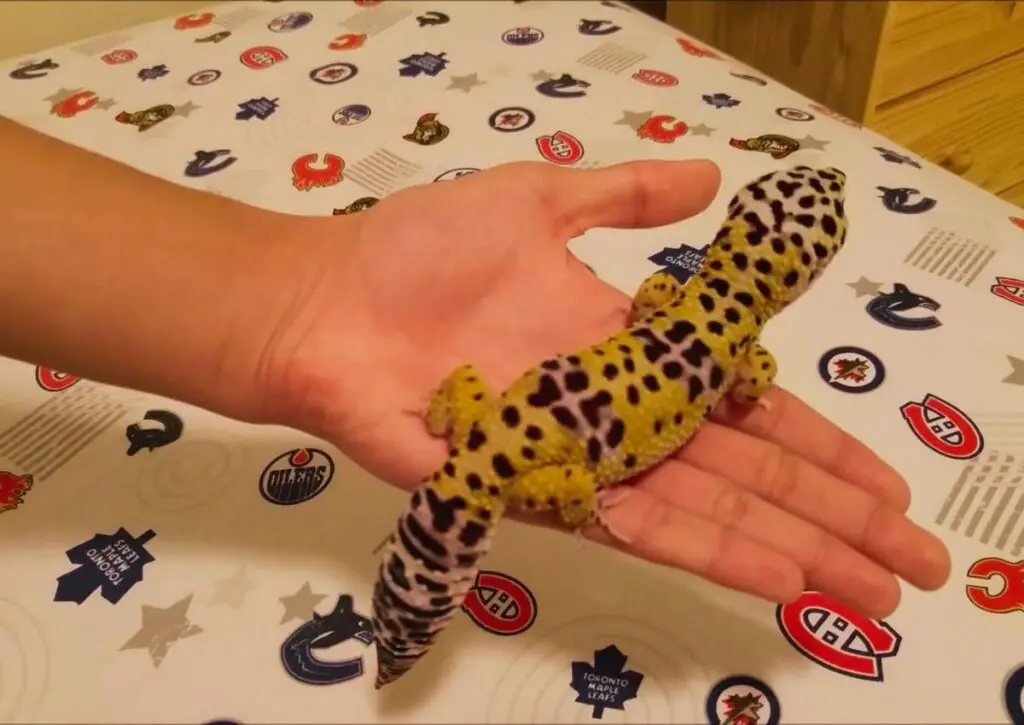
As stated at the beginning of this article, caring for Leopard geckos is not tricky. You need to know when and how to do certain things that can affect your Leopard gecko’s health.
The type of care that you give your lizard friend will not only determine their overall health but may impact their lifespan as well.
This applies to both regular and other Leopard gecko morphs. If you are planning on keeping a Leopard gecko, you need to learn about some of the things that can make them sick.
Also, you should familiarize yourself with foods and care practices that can keep your lizard healthy. And like all other pets, Leopard geckos require proper husbandry.
You should practice good husbandry from an early stage to avoid health complications.
If you have hatchlings, ensure that you give them the right foods and supplements. In addition to this, the environmental conditions should be favorable for growth.
The type of care offered may, however, vary depending on the gecko’s age and sex. Female Leopard geckos may require special care in certain stages of their lives.
Common Terminologies Used In Leopard Gecko Morph Breeding
Out-crossing
This is the breeding of two Leopard geckos with distinct characteristics. The difference can come about in terms of color, pattern, size, and other physiological traits.
Dominant Gene
A dominant gene often expresses itself more than another gene. In Leopard gecko morph breeding, the offspring will resemble the parent with the dominant gene.
Genotype
This refers to all gene-based characteristics that make up an organism.
Phenotype
These are a set of physical traits that you can observe in an organism.
Recessive Gene
This is the opposite of a dominant gene. Offspring can only acquire recessive traits when both lizards donate a recessive gene.
Homozygous
This is a term used to refer to a situation in which the male and female Leopard gecko carries the same gene. In nutshell, it means both genes are dominant or recessive.
Heterozygous
Heterozygous genotypes stand in stark contrast to homozygous genotypes.
Line-bred
This refers to morphs that are bred from parents with specific genetic traits. Such morphs often have superior traits to their parents.
Wild Type
Wild type, commonly abbreviated as WT, refers to the phenotypical traits of Leopard geckos as they are when in their natural environment.
Codominant Traits
When two genes are simultaneously dominant in Leopard geckos, it is said that they are codominant.
Diseases can prevent your pet lizard from growing properly. A good example is nutritional secondary hyperparathyroidism (NSHP). NSHP comes about due to calcium deficiency in Leopard geckos.
Leopard geckos with NSHP are also likely to be underweight.
Still, ensure that you take your lizard to the vet if you notice that they are not growing. The veterinarian will provide you with a prognosis and may also offer advice on how best you can care for your Leo.
Types of Leopard Gecko Morphs
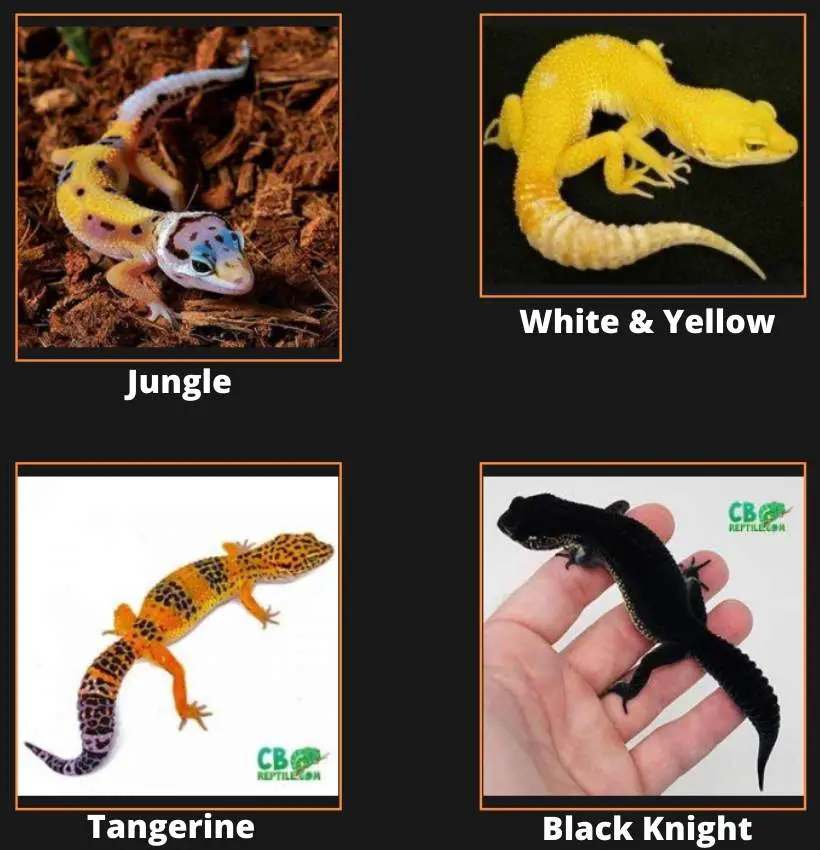
A stated earlier, there are different types of Leopard gecko morphs. In most cases, morphs are classified by color, size, or pattern.
Currently, there are up to six common distinguishable categories of Leopard gecko morphs that you can go for:
This category of morphs is the common geckos that you find in most pet stores.
These morphs are not only readily available but also cost less compared to other Leopard gecko morphs. This does not, however, mean that they are less resilient to diseases.
There are two types of Normal Morphs:
Wild Type
This is the term used to refer to typical Leopard geckos. Normal morphs are yellow with dark spots covering a large percentage of their skin.
High Yellow
As the name suggests, the yellow color is more conspicuous in the High Yellow morph. These types of lizards also have spots on their bodies, but they are fewer than those of the Wild type.
Albinism is a genetic disorder where an organism lacks melanin pigment. Albino Leopard geckos are not lacking in melanin but have less pigment in their skin.
Albino Leopard gecko morphs come in three distinctive types:
Bell Albino
Bell albino morphs often have brown spots, lavender-ish hue, and light-pink eyes.
Tremper Albino
This is probably one of the oldest albino morphs in this category. They were discovered before the other morphs.
Like the Bell albino morph, most Tremper morphs have a brown pigment on some parts of their skin.
Nonetheless, some lizards are orange or yellow. A few have pink pigment. Tremper albinos often have silverfish eyes.
Rainwater Albino
Rainwater albinos are somewhat smaller than the Tremper albino and Bell albino morphs. Additionally, they are lighter in color and have some element of pink color.
The Leopard gecko morphs in this category are named so due to their extraordinary size. They are larger and also grow faster compared to most morphs
Giant Leopard Gecko Morphs can be classified as:
Giant
The Giant Leopard gecko is naturally big. Most of them resemble other gecko morphs in terms of color and pattern.
Super Giant
When you breed two giant morphs, you are likely to get a Super giant. This can only apply if the dominant gene overpowers the recessive gene, resulting in a homozygous hatchling.
Unlike most morphs that have spots on their bodies, striped morphs have unique pattern stripes running along their sides or backs. This morph is a perfect example of incomplete recessive.
The common types of striped morphs are:
Red Stripe
Red stripe morphs are known for their bright reddish patterns striping down on either side of their body.
These morphs are not born with the stripes but they develop them over time as they grow.
Bold Stripe
Bold stripe Leopard gecko morphs are very beautiful to look at. They have a characteristic pattern that strips down on the side of their body, giving them a unique appearance.
Raining Red Stripe
Raining red stripe Leopard gecko morphs are a result of an out-crossing between a Red stripe and Rainwater albino morph.
Like the Red stripe morph, they have reddish stripes, but the only difference is that their pigmentation somewhat resembles that of Rainwater morphs.
Blizzard morph Leopard geckos have no pattern at all on their bodies. Most Blizzard morphs are either yellow or white, while others are a combination of both. Nonetheless, some morphs are purple in color.
The most common type of Blizzard morph is the Banana Blizzard. Leopard gecko breeders can get this morph by out-crossing a Murphy Patternless morph and a Blizzard.
The result is an offspring that is brightly colored than the Blizzard morph and more patternless than the Murphy.
The term melanistic is derived from melanin, so this category of morphs can be grouped in terms of color density.
There are two categories of Melanistic morphs:
1. Hypomelanatic
Hypomelanatic Leopard gecko morphs have less melanin, meaning the spots on their bodies are not as visible ad are also few.
A Leopard gecko can only be hypomelanatic when they have ten or fewer spots on its body.
Example of Hypomelanatic Leopard Geckos:
-
Super Hypo
Super hypo morphs lack spots on their actual bodies. However, they have a few spots on their tails and certain parts of their heads. -
Ghost morphs
Ghost morphs or Hypo ghosts have greatly reduced color pigmentation, thus giving them a light-colored appearance. -
Hybino
To get a hybino, you have to out-cross albino morphs with a Super hypo. The offspring will have a wide range of colors, depending on the parents' genetic traits. -
Baldy Leopard Gecko
Baldy Leopard geckos are somewhat similar to the Super hypo, but the only difference is that the former does not have spots on their heads.
2. Hyper Melanistic
Hyper Melanistic Leopard geckos have darker pigments compared to their hypomelanatic counterparts.
Lizards in this category have more melanin, but the spots on their spots are not black. They have different patterns and are equally colorful.
If you are in search of an eye-catching pet lizard, the Hyper melanistic morph is one of the options that you can go for.
Other Common Leopard Gecko Morphs
RAPTOR
The term RAPTOR is an acronym for Red-Eye Albino Patternless Tremper Orange. Raptors have orange bodies and red eyes with no black spots. They are a good example of a combination morph.
Aberrant Morphs
Aberrant Leopard gecko morphs are known for their beautiful broken patterns. The pattern inconsistency not only makes them aesthetically appealing but also unique.
Halloween Mask Morphs
The Halloween mask Leopard gecko has bold patterns on its head, which may change from time to time as they continue to grow.
Note: These are just but some of the common Leopard gecko morphs. The list is endless. Plus, gecko breeders are coming up with new morphs every year, so the number will continue to grow.
How to Care For a Female Leopard Gecko during Ovulation
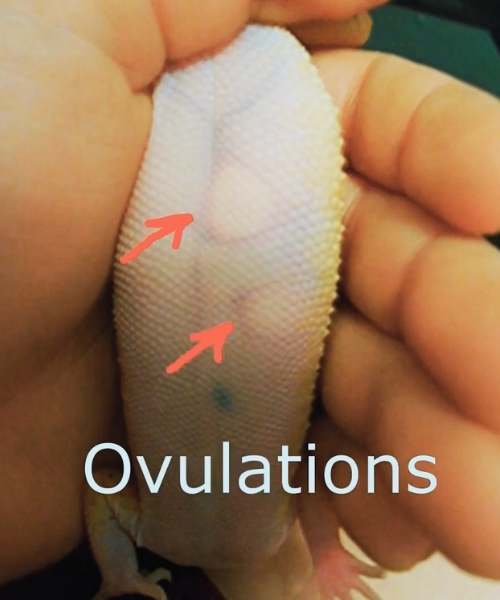
Signs Of Ovulation In Leopard Geckos
Female Leopard geckos ovulate several times a year during the breeding season. Ovulation is a normal biological process and can occur even if the female is not housed with a male.
Leopard geckos can only ovulate when they reach sexual maturity, which often occurs when they are 18 to 24 months old.
During ovulation, you may notice several behavioral changes in your Leopard gecko. The changes may occur gradually or rapidly, so you should be keen to spot them
You can only provide your Leopard gecko with the right care during ovulation if you are familiar with the signs.
The common signs of ovulation in Leopard geckos are:
Loss Of Appetite
When female Leopard geckos are ovulating, they tend to eat less. This results from the changes that occur inside the lizard’s body.
During this period, the gecko will create more space for the eggs by constricting its stomach. This does not mean that you should stop giving the lizard food.
The egg formation process is also energy-taxing, so some geckos may be too weak to eat most of the time. Nonetheless, this shouldn’t worry you as much since it is temporary.
Swollen Abdomen
As the eggs continue to grow, the Leopard gecko’s abdomen may bulge slightly. Also, certain parts of the underbelly may become reddish due to increased blood supply.
If you suspect your Leopard gecko is pregnant, you can gently feel the abdomen for the eggs. You should exercise caution to avoid causing injury to the lizard or damaging the eggs.
Note: The fact that your Leopard gecko is ovulating does not necessarily mean that you should breed them. Ensure that you consult your vet to avoid breeding complications.
Caring For Pregnant Leopard Geckos
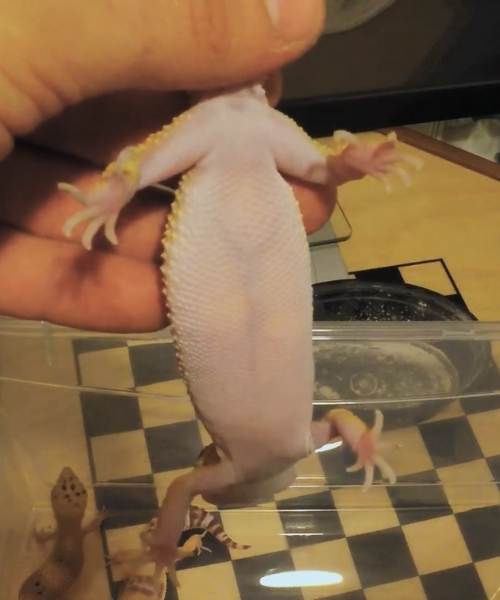
In case you decide to breed your Leopard gecko, there are certain things that you will have to do to keep them healthy. It’s not only essential to keep your mother Leopard gecko healthy, but the eggs as well. Here are the top tips when it comes to caring for a pregnant Leopard gecko.
Provide The Leo With Supplements
Leopard geckos need supplements such as calcium during the egg formation process. You can keep your pet lizard healthy by incorporating calcium supplements into their diet.
Aside from that, you should consider providing your Leopard gecko with high calcium foods to prevent nutritional deficiencies.
Limit Handling
When dealing with pregnant Leopard geckos, you should limit handling. You should only handle the lizard when it is necessary.
This is done to avoid damaging the eggs that are still forming inside the lizard. Additionally, this will save your Leopard gecko from unnecessary discomfort.
Place The Gecko In a Separate Enclosure
If you have been housing multiple Leopard geckos in the same tank, you should consider separating the pregnant Leos from the other lizards.
That way, they won’t have to struggle for food, basking spot, and other resources such as water.
You should use an enclosure that is large enough for your Leopard gecko to encourage movement.
According to expert Leopard gecko keepers, the enclosure should be placed in a quiet place. This will save the gecko from stress and other problems that may come about due to loud noises.
Provide The Leopard Gecko With A Nesting Box
Like most lizards, Leopard geckos prefer laying their eggs underground. As such, ensure that you place a nesting box inside the enclosure.
Also, the nesting box should have the right type of substrate since this will give the lizard an easy time when burying the eggs.
Most lizard keepers use vermiculite and sphagnum moss. These substrates provide the lizard with the perfect conditions during the egg-laying process.
To get maximum results, you should consider wetting the substrate by spraying it with water. However, you should not apply too much water as this can encourage mold growth inside the nesting box.
If given the right care, female Leopard geckos won’t experience any problems during the breeding season.
Leopard geckos are easy to care for, but that does not mean that it is an effortless process. Besides, it is your responsibility to ensure that the lizard has a good diet and a safe environment.
You should pay particular attention to your Leopard geckos housing. Inadequate housing can result in stress, illness, or even death. Here are some tips that can help you provide your Leopard gecko with the suitable housing and care:
Never House Multiple Males In The Same Enclosure
Leopard geckos are territorial, so they are likely to fight for space, food, mates, and other resources.
Males are notorious for starting duels, which can often get bloody. Therefore, you shouldn’t keep more than one male in the same vivarium.
The same applies to female Leopard geckos. Although less rare, female Leopard geckos are also known to fight. The common consensus is you should never house any Leopard geckos in the same enclosure.
Clean The Enclosure Regularly
Hygiene is critical and also has a direct impact on your Leopard gecko’s health. Bad hygiene can lead to intestinal parasites and other diseases.
To avoid this, you should clean the tank regularly to prevent parasite build-up. Certain types of bacteria and viruses can thrive in dirty environments.
It would be best if you also cleaned the accessories inside the enclosure to keep the gecko healthy. It is also advisable that you change the substrate in each cleaning session.
To avoid causing harm to your Leopard gecko, you should only use mild disinfectants when cleaning the enclosure.
Proper Ventilation
Adequate ventilation is necessary for all Leopard gecko enclosures. This will supply the lizards with clean air, allowing them to stay healthy.
Enclosures with good ventilation can effectively regulate humidity levels. Thus, preventing possible cases of pneumonia and other respiratory complications in Leopard geckos.
Location
It would be best if you never placed your leopard gecko’s enclosure in direct sunlight. Otherwise, it may result in temperature fluctuations and cause discomfort to your gecko.
As such, you should avoid placing gecko vivariums next to windows or any other area exposed to the sun.
The enclosure should also be placed in an area that is easily accessible to avoid accidents when handling the lizard.
Importance of Leopard Gecko Care
Leopard geckos are some of the best pet lizards that you can consider keeping. They are not only beautiful but also have amazing personalities.
Best of all, they are docile and equally friendly once they get used to you. However, you must have the knowledge to care for your Leopard gecko properly.
With the help of this leopard gecko care guide, we hope you’re able to have a great experience with your new reptile!

